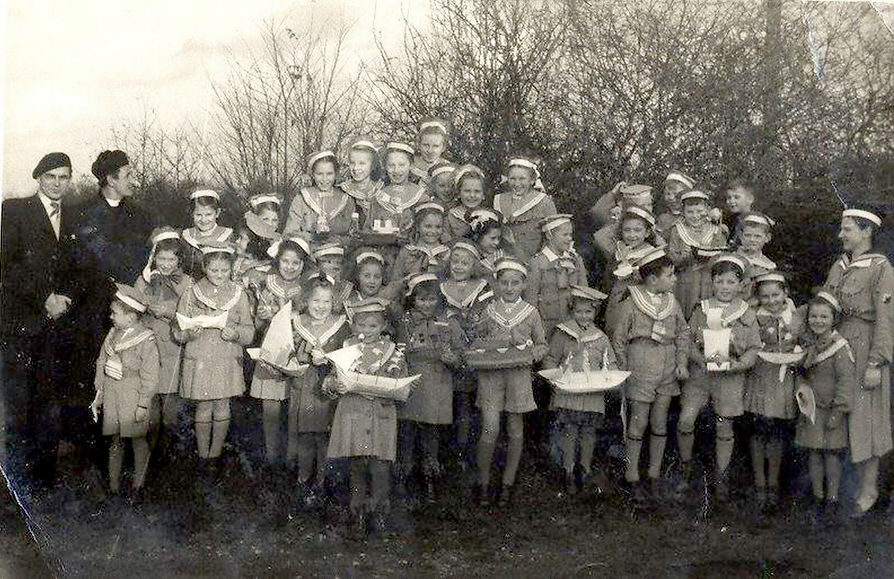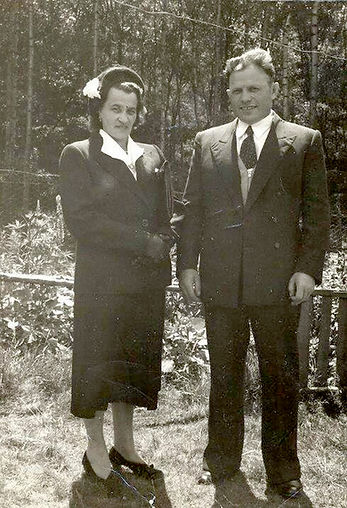
Piotrowski Family in Buckinghamshire, UK
Buckinghamshire camps which reunited war-torn Polish communities
Buckinghamshire article - 27 October 2014 - by Lorcan Lovett
Grandmother who was born in woods near Chalfont St Giles tells of her childhood at one of the many camps in the county.
Krystyna Piotrowska Freiburger had an astounding childhood.
Despite her staunchly Polish first name, she was born in Chalfont St Giles. More unusually, she was born in Hodgemoor Woods amid a makeshift camp against the backdrop of a blighted and war-weary Europe. Camps like hers sprung up across the country after the Second World War to accommodate thousands of displaced Polish families.
A number had escaped Nazi concentration camps, but the majority came from the gulags of Siberia. Poles were sent to these desolate prisons after the Soviets invaded the eastern part of the country. Nazis had invaded the western part days before.
Two of Krystyna’s brothers died in Siberia. Her parents left when the Soviets granted
Poles ‘amnesty’ in 1941.
Her father went to fight in Persia, now Iran, while her eldest brother and mother were sent to Northern Rhodesia, now Zambia.
Her family reunited immediately after the war in Buckinghamshire, where empty barracks, formerly used by Canadian and American forces, across the countryside served as temporary housing. The county had camps in Iver, Beaconsfield and Great Missenden to name a few sites. But Krystyna, who was born on March 22, 1949, grew up with other exiles in the woods of Chalfont St Giles.
“My vivid memories of Hodgemoor are nothing but filled with joy,” said Krystyna. “I remember the happy days I spent playing in our yard which had a large garden, chickens, geese, rabbits and a cat. And the best was the woods behind us where my brother, my friends and I spent hours roaming around and climbing trees.”
Life was more of a struggle for the adults, says Zosia Biegus, 71, who also lived in a camp and co-authored the book Polish Resettlement Camps in England and Wales. They had to learn a new language, look for work and try to keep their culture alive.
Many half-hoped the west would recognise how ‘evil’ the Soviets were, says Zosia, and begin a third world war which would pave the way home for the Poles. However, hopes were dashed when the Soviets brutally put down the Hungarian Revolution of 1956. Zosia said: “It was then that Poles decided we have to stay in this country and we have to assimilate and build an Anglo-Polish relationship.”
Back in Hodgemoor, a young Krystyna explored her surroundings. “During the week I went to school in the village. A little van from our camp drove us there and back every day. As a child, I thought Chalfont St Giles was pretty and exotic. People here spoke another language and lived in different homes to the barracks we had. School was hard until I learned English. We were served lunch with food I was not familiar with.”
“Most vivid in my mind are the Christmas parties they put on for us in the community hall next to the school. I can still feel the awe when, as children, we walked into this enchanted hall decorated in Christmas splendour.”
Richard Tramp, 64, of Oldfield Close, Little Chalfont, lived in the camp for 10 years and played with Krystyna when they were children. His family history is equally as dramatic, encompassing gulags and battles in the Middle East.
He said: “Krystyna’s is a great story, the fact that her first language was Polish and she remembered all about her history.”
Richard recollects Poland international football players living at the camp and clubs such as Arsenal and Fulham visiting for a game.
His family were then moved to Popes Close, in Amersham, when the camp closed. His mother, 92-year-old Genowefa Tramp, still lives in that same house while Richard moved out, started a roofing business and became chairman of the Amersham Polish Club.
He added: “[The Polish) were privileged people because the authorities allowed them to settle in these camps and carry on the fight for Polish freedom.”
Hodgemoor, now popular with walkers and horse riders, once had its own chapels, community hall, store and bar. A small monument is the only giveaway to the abandoned commune.
Krystyna reflected: “Together as a community, we continued to keep our language, our traditions and culture. This sense of belonging helped the adults to survive the tough times after the war. When I am stressed out and need a beautiful place to imagine in my head, I always return in my mind to there and the peaceful countryside surrounding them.”
The camp was closed in 1958 while the final camps in the country were closed in the late 60s. Young children who had never set foot on their homeland continued life in their adopted country.
Mother-of-four and grandmother-of-five Krystyna now lives in Canada after her father found work there. She said: “I look forward to the day that I will be able to take my grandkids to Hodgemoor and Chalfont St Giles and tell them all about my happy childhood there.”
Polish resettlement camps in Buckinghamshire. Information from www.polishresettlementcampsintheuk.co.uk :
-
Hodgemoor woods, Chalfont St Giles, 1947 to 1959 (families)
-
Bower Wood, Beaconsfield Buckinghamshire, 1955 to 1956 (families)
-
Great Missenden Woodlands Park camp, 1956 (military and families)
-
Hazlemere, High Wycombe, 1948 to 1956 (families)
-
Grove Park, Iver, late 40s to 1957 (military camp occupied by squatters, families of Polish soldiers with no were else to go, who were evicted)
-
Pipers Wood camp, Amersham, 1949 (occupied by squatters)
Copyright: Trinity Mirror Southern

Krystyna Piotrowska

Members of Zuchy (Brownies)

Krystyna and friends dressed as sailors

Krystyna's parents

Krystyna Piotrowska

First Communion

Krystyna Piotrowska

Chairman of the Polish Club at the camp monument

Corpus Christi procession

Krystyna Piotrowska in Canada, with her grandchildren